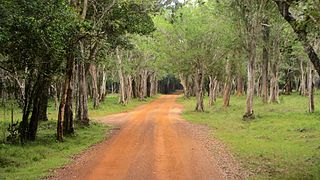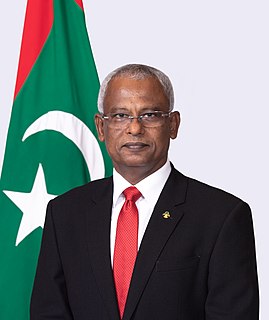Related Research Articles

Sinhalese people are an Indo-Aryan ethnic group of the island of Sri Lanka. They were historically known as Hela people. They constitute about 75% of the Sri Lankan population and number greater than 16.2 million. The Sinhalese identity is based on language, cultural heritage and nationality. The Sinhalese people speak Sinhala, an insular Indo-Aryan language, and are predominantly Theravada Buddhists, although a minority of Sinhalese follow branches of Christianity and other religions. Since 1815, they were broadly divided into two respective groups: The 'Up-country Sinhalese' in the central mountainous regions, and the 'Low-country Sinhalese' in the coastal regions; although both groups speak the same language, they are distinguished as they observe different cultural customs.

Anuradhapura is a major city in Sri Lanka. It is the capital city of North Central Province, Sri Lanka and the capital of Anuradhapura District. Anuradhapura is one of the ancient capitals of Sri Lanka, famous for its well-preserved ruins of an ancient Sinhala civilization. It was the third capital of the kingdom of Rajarata, following the kingdoms of Tambapanni and Upatissa Nuwara.
Tissa may refer to:

The Thamirabarani or Tamraparni or Porunai is a perennial river that originates from the Agastyarkoodam peak of Pothigai hills of the Western Ghats, above Papanasam in the Ambasamudram taluk. It flows through Tirunelveli and Thoothukudi districts of the Tamil Nadu state of southern India into the Gulf of Mannar. It was called the Tamraparni River in the pre-classical period, a name it lent to the island of Sri Lanka. The old Tamil name of the river is Porunai. From the source to sea, the river is about 128 kilometres (80 mi) long and is the only perennial river in Tamil Nadu. This river flows towards north direction initially. However, it changes to east direction later.

According to the Mahāvaṃsa chronicle, Prince Vijaya was the first Sinhalese king. Legends say that he and several hundred followers came to Sri Lanka after they were banished from Sinhapura.
Kuveni(කුවේණි / குவேனி) also known as Sesapathi or Kuvanna or Leelawathi, was a Yakshini queen in Sri Lanka mentioned in the ancient Pali chronicles Mahavamsa and Dipavamsa of the Sinhalese people. The primary source for her life-story is the Mahavamsa. She is venerated as Maha Loku Kiriammaleththo by the Veddas. Other names for her varying with Veddas habitats are Indigolle Kiriamma, Unapane Kiriamma, Kande Kiriamma, Divas Kiriamma, Wellasse Kiriamma, Kukulapola Kiriamma and Bili Kiriamma.
Tamraparni is an older name for multiple distinct places, including Sri Lanka, Tirunelveli in India, and the Thamirabarani River that flows through Tirunelveli.

Wilpattu National Park is a national park in Sri Lanka. The unique feature of this park is the existence of "Willus" – natural, sand-rimmed water basins or depressions that fill with rainwater. Located on the northwest coast lowland dry zone of Sri Lanka, the park is 30 km (19 mi) west of Anuradhapura and 26 km (16 mi) north of Puttalam. The park is 1,317 km2 (508 sq mi) in area and ranges from 0–152 m (0–499 ft) above sea level. Nearly one hundred and six lakes (Willu) and tanks are found spread throughout Wilpattu. Wilpattu is the largest and one of the oldest national parks in Sri Lanka. Wilpattu is world-renowned for its leopard population. A remote camera survey conducted in Wilpattu from July to October 2015 by the Wilderness and Wildlife Conservation Trust captured photographs of forty-nine individual leopards in the surveyed area, the core area density of which was between that of Yala National Park's Block I and Horton Plains National Park.

The current capital of Sri Lanka is Sri Jayawardenepura Kotte. In the course of history, the national capital has been in many locations other than Sri Jayawardenepura Kotte.
Upatissa is a Sinhala name and may refer to:

The Kingdom of Tambapaṇṇī was the first Sinhalese kingdom in Sri Lanka. Its administrative centre was based at Tambapaṇṇī. It existed between 543 BC and 437 BC. The Kingdom was founded by Prince Vijaya and his followers.
Upatissagāma was the second capital of the Kingdom of Tambapanni, during the Pre Anuradhapura period of Sri Lanka. It was seven or eight miles further north of the previous capital Tambapaṇṇī, which was in present-day Puttalam. The city was established by Upatissa, a follower and senior minister of Vijaya.

Rajarata [rā dja ra tə] was one of three historical regions of the island of Sri Lanka for about 1,700 years from the 6th century BCE to the early 13th century CE. Several ancient cities, including Tambapanni, Upatissa Nuwara, Anuradhapura and Polonnaruwa, were established as capitals within the area by successive rulers. Rajarata was under the direct administration of the King. Two other areas, Malayarata and Ruhunurata, were ruled by the king's brothers "Mapa" and "Epa". The Magha invasion in the 13th century brought about the end of the Rajarata kingdom.

The House of Vijaya was the first recorded Sinhalese royal dynasty that ruled over the island, Sri Lanka. According to Sinhalese folklore Prince Vijaya is the traditional first king of Sri Lanka, founding the Kingdom of Tambapanni and the dynasty subsequently founding the Kingdom of Upatissa Nuwara and finally the Anuradhapura Kingdom.
Throughout its history, Sri Lanka, as it is known today, has been ruled by various monarchial lines, at some times with different lines ruling different parts of the modern state, or the entire state.

The Sinhalese monarchy has its origins in the settlement of North Indian Indo-Aryan immigrants to the island of Sri Lanka. The Landing of Vijay as described in the traditional chronicles of the island, the Dipavamsa, Mahavamsa and Culavamsa, and later chronicles, recount the date of the establishment of the first Sinhala Kingdom in 543 BC when Prince Vijaya, an Indian Prince, and 700 of his followers landed on the island of Sri Lanka and established the Kingdom of Tambapanni. In Sinhalese mythology, Prince Vijaya and followers are told to be the progenitors of the Sinhalese people. However according to the story in the Divyavadana, the immigrants were probably not led by a scion of a royal house in India, as told in the romantic legend, but rather may have been groups of adventurous and pioneering merchants exploring new lands.

The Pre-Anuradhapura period of Sri Lankan history begins with the gradual onset of historical records in the final centuries of the prehistoric period and ending in 437 BC. According to the Mahavamsa, the original inhabitants of Sri Lanka are the Yakshas and northern Naga tribes. Sinhalese history traditionally starts in 543 BC at the arrival of Prince Vijaya, a semi-legendary king who was banished from the Indian subcontinent with his 700 followers, and is recorded in the Mahavamsa chronicle. This period was succeeded by the Anuradhapura period.

Ibrahim Mohamed Solih, better known as Ibu (އިބޫ), is a Maldivian politician and the current President of the Maldives who assumed office on 17 November 2018.

Dulichius is a genus of bugs in the family Alydidae and tribe Micrelytrini. It is notable for species which are ant mimics.
References
- ↑ "Tambapanni". www.palikanon.com. Retrieved 27 February 2013.